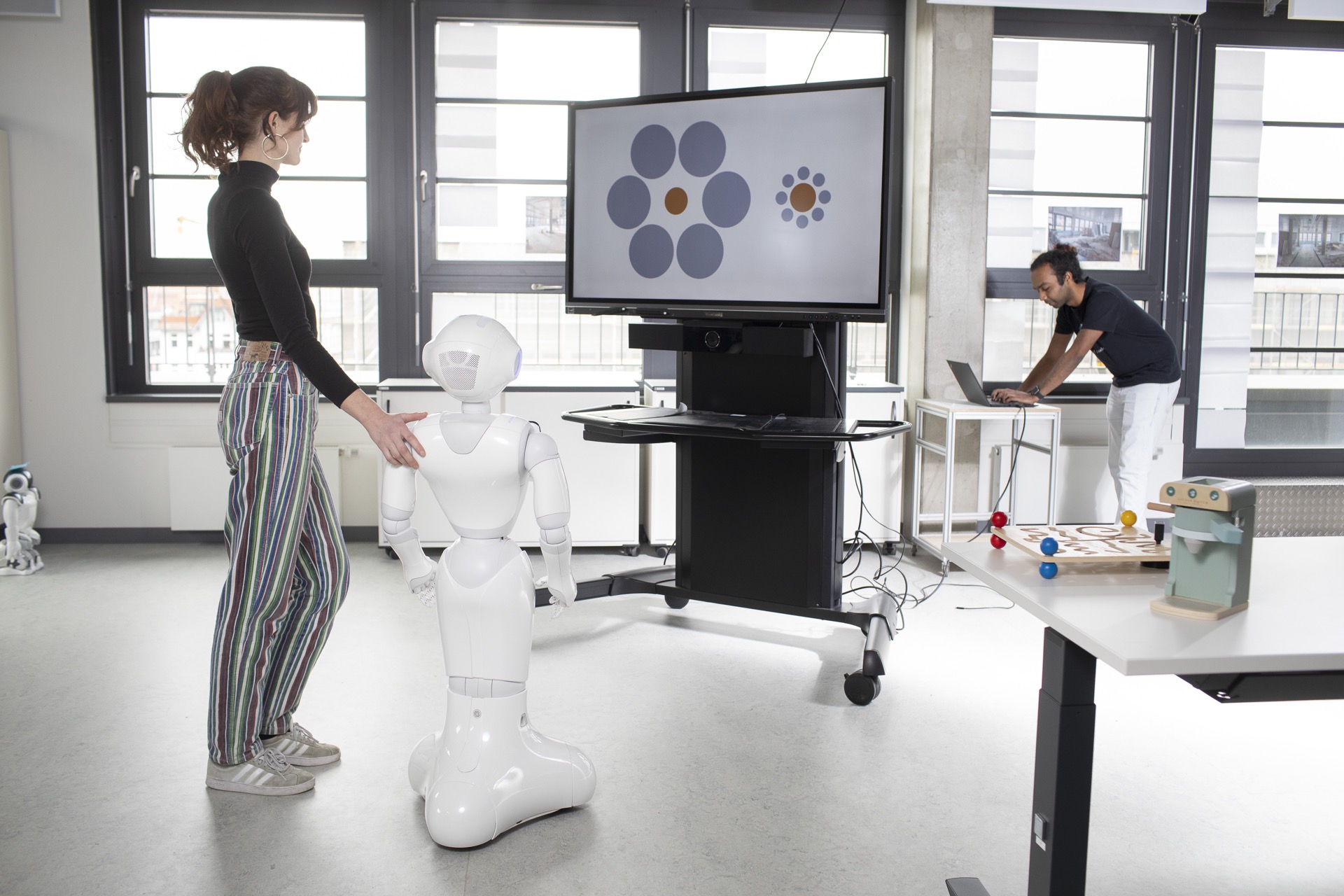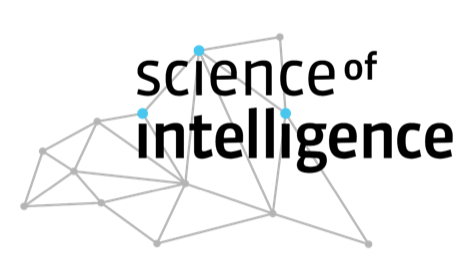A study on human and robot perception and the architecture of perceptual information processing

@SCIoI
This research project investigates human and robot perception and aims to develop a constructive understanding of perceptual information processing. We will create models using an information processing pattern that originated in robotics to understand perceptual mechanisms in human vision. The information processing pattern possesses similar high-level characteristics to human visual information processing, and thus has capabilities to generate similar behavior. We will apply this in an analytic-synthetic loop, simultaneously modeling while collecting psychophysical data, and adjusting the model with new observations. Based on the resulting insights we will produce an algorithmic model of human perception, capable of replicating visual phenomena and of making meaningful predictions about experimental outcomes. We will also produce robot perception algorithms that leverage insights about the human perceptual system to advance the state of the art in the synthetic disciplines.
Project Results
AICON: A Computational Framework To Exploratively Study Human Vision
The team’s main topic of investigation is a computational framework—AICON (Active InterCONnect)—and its capabilities to model robust visual perception. AICON originates from robotics and has proven effective in solving many complex robotic perception tasks. Motivated by a striking similarity between illustrations of this algorithm from robot perception and depictions of information processing in the human visual system, the team hypothesized that AICON could serve as a useful representation for exploring aspects of human vision. The similarity in illustrations highlighted a crucial aspect of information processing that is typically not leveraged deeply–rich and dynamic interactions between modules of a system. They suppose this characteristic of information processing, baked into AICON, occurs in many instances of robust systems, and thus identify this recurring pattern as a candidate principle of intelligence. Using AICON, they investigated mechanisms behind human visual perception, focusing on two visual illusions: shape-contingent color aftereffects and motion silencing. These illusions reveal intriguing interactions between basic perceptual processes in human vision, viz., between color and shape processing, and between motion and brightness (luminance) perception respectively. In modeling these illusions, the team found that the models forecasted the observations seen in humans, accounted for inter-individual differences in subjective human perception, and guided further psychophysical experiments. This demonstrates AICON’s capacity to capture biologically relevant characteristics of information processing.
Despite their simplicity, AICON-based models generate precise qualitative predictions that accurately forecast unexpected properties of the human visual system. This success stems from AICON’s structured approach to expressing dynamic, interdependent processes—a crucial aspect of perception often overlooked in both computational models and robotic system design. The team’s work shows that we can indeed articulate this simple computational pattern (or inductive bias) that occurs in artificial and biological instances. This in turn enables them to model interesting biological phenomena and gain insights into the underlying mechanisms particular to those phenomena. This computational framework has the potential to enable quick advancements in understanding intelligent information processing (both natural and artificial).
Extending The Study Of Human Vision Through Illusions to 3D Environments
The team is currently investigating the extension of one of the visual illusions studied above, in 3D using virtual reality. This phenomenon probes the interaction of color and shape, as well as spatial and action processing. Early evidence suggests that some perceptual effects held to be originating from 2D organization of visual processing in the brain may indeed originate from 3D spatial processing and attentional factors. Participants show a dependency on depth (perhaps also size, because the size depends on how far an object is) and interaction. People report stronger perception of the illusion the farther an object is in the virtual environment. They also report stronger percepts for objects they virtually interact with. This points to the need to revise theories based on controlled lab studies to account for the brain’s ecological processing in real-world environments.
Gaze Fixation and Robust Visual Perception
The team also took the investigation of effective spatial processing further by studying robots. In particular, they studied the consequences of gaze fixation for robotic perception. When humans move about, they fixate their gaze on objects of interest without conscious notice. They found that taking advantage of the regularity between an agent’s eye movements and environment enables robust 3D perception under conditions that challenge traditional 3D (depth) sensors. Their research shows that fixating on one object at a time simplifies perception for any moving agent. It provides robust and instantaneous information crucial to interact with the fixated object: how far it is and how other objects are positioned with respect to it. This information can be easily adapted to various robotic behaviors, including picking objects in challenging scenarios. Distance estimation using fixation outperforms that of a translating camera, and determining obstacles is immune to common problems for vision such as translucent and reflective surfaces. This suggests that active vision techniques like fixation that leverage the principle of agent-environment couplings reflect key aspects of biological visual intelligence and can be effectively implemented in robotic systems.
On Validating Principles of Intelligence
Finally, as a key objective of this project, the team aimed to add support to candidate principles of intelligence identified within SCIoI. Their findings above show that we gathered evidence for the validity and utility of two principles on both biological as well as artificial substrates, namely principle of active interconnections and principle of agent-environment computation.
Related Publications +
2756394
proj002
1
apa
50
creator
desc
year
20156
https://www.scienceofintelligence.de/wp-content/plugins/zotpress/
%7B%22status%22%3A%22success%22%2C%22updateneeded%22%3Afalse%2C%22instance%22%3Afalse%2C%22meta%22%3A%7B%22request_last%22%3A0%2C%22request_next%22%3A0%2C%22used_cache%22%3Atrue%7D%2C%22data%22%3A%5B%7B%22key%22%3A%229ZNGL3SY%22%2C%22library%22%3A%7B%22id%22%3A2756394%7D%2C%22meta%22%3A%7B%22creatorSummary%22%3A%22Mengers%20et%20al.%22%2C%22parsedDate%22%3A%222023%22%2C%22numChildren%22%3A1%7D%2C%22bib%22%3A%22%26lt%3Bdiv%20class%3D%26quot%3Bcsl-bib-body%26quot%3B%20style%3D%26quot%3Bline-height%3A%202%3B%20padding-left%3A%201em%3B%20text-indent%3A-1em%3B%26quot%3B%26gt%3B%5Cn%20%20%26lt%3Bdiv%20class%3D%26quot%3Bcsl-entry%26quot%3B%26gt%3BMengers%2C%20V.%2C%20Battaje%2C%20A.%2C%20Baum%2C%20M.%2C%20%26amp%3B%20Brock%2C%20O.%20%282023%29.%20Combining%20Motion%20and%20Appearance%20for%20Robust%20Probabilistic%20Object%20Segmentation%20in%20Real%20Time.%20%26lt%3Bi%26gt%3BICRA%202023%26lt%3B%5C%2Fi%26gt%3B.%20%26lt%3Ba%20class%3D%26%23039%3Bzp-DOIURL%26%23039%3B%20href%3D%26%23039%3Bhttps%3A%5C%2F%5C%2Fdoi.org%5C%2F10.1109%5C%2FICRA48891.2023.10160908%26%23039%3B%26gt%3Bhttps%3A%5C%2F%5C%2Fdoi.org%5C%2F10.1109%5C%2FICRA48891.2023.10160908%26lt%3B%5C%2Fa%26gt%3B%26lt%3B%5C%2Fdiv%26gt%3B%5Cn%26lt%3B%5C%2Fdiv%26gt%3B%22%2C%22data%22%3A%7B%22itemType%22%3A%22conferencePaper%22%2C%22title%22%3A%22Combining%20Motion%20and%20Appearance%20for%20Robust%20Probabilistic%20Object%20Segmentation%20in%20Real%20Time%22%2C%22creators%22%3A%5B%7B%22creatorType%22%3A%22author%22%2C%22firstName%22%3A%22Vito%22%2C%22lastName%22%3A%22Mengers%22%7D%2C%7B%22creatorType%22%3A%22author%22%2C%22firstName%22%3A%22Aravind%22%2C%22lastName%22%3A%22Battaje%22%7D%2C%7B%22creatorType%22%3A%22author%22%2C%22firstName%22%3A%22Manuel%22%2C%22lastName%22%3A%22Baum%22%7D%2C%7B%22creatorType%22%3A%22author%22%2C%22firstName%22%3A%22Oliver%22%2C%22lastName%22%3A%22Brock%22%7D%5D%2C%22abstractNote%22%3A%22%22%2C%22date%22%3A%222023%22%2C%22proceedingsTitle%22%3A%22ICRA%202023%22%2C%22conferenceName%22%3A%22%22%2C%22language%22%3A%22%22%2C%22DOI%22%3A%2210.1109%5C%2FICRA48891.2023.10160908%22%2C%22ISBN%22%3A%22%22%2C%22url%22%3A%22%22%2C%22collections%22%3A%5B%5D%2C%22dateModified%22%3A%222025-09-26T13%3A16%3A16Z%22%7D%7D%2C%7B%22key%22%3A%22F4YHRSTW%22%2C%22library%22%3A%7B%22id%22%3A2756394%7D%2C%22meta%22%3A%7B%22creatorSummary%22%3A%22Mengers%20et%20al.%22%2C%22parsedDate%22%3A%222025%22%2C%22numChildren%22%3A1%7D%2C%22bib%22%3A%22%26lt%3Bdiv%20class%3D%26quot%3Bcsl-bib-body%26quot%3B%20style%3D%26quot%3Bline-height%3A%202%3B%20padding-left%3A%201em%3B%20text-indent%3A-1em%3B%26quot%3B%26gt%3B%5Cn%20%20%26lt%3Bdiv%20class%3D%26quot%3Bcsl-entry%26quot%3B%26gt%3BMengers%2C%20V.%2C%20Battaje%2C%20A.%2C%20%26amp%3B%20Brock%2C%20O.%20%282025%29.%20%26lt%3Bi%26gt%3BAICON%3A%20A%20Representation%20for%20Adaptive%20Behavior%26lt%3B%5C%2Fi%26gt%3B.%201st%20German%20Robotics%20Conference.%20%26lt%3Ba%20class%3D%26%23039%3Bzp-ItemURL%26%23039%3B%20href%3D%26%23039%3Bhttps%3A%5C%2F%5C%2Fwww.static.tu.berlin%5C%2Ffileadmin%5C%2Fwww%5C%2F10002220%5C%2FPublications%5C%2FMengers-Battaje-GRC-25.pdf%26%23039%3B%26gt%3Bhttps%3A%5C%2F%5C%2Fwww.static.tu.berlin%5C%2Ffileadmin%5C%2Fwww%5C%2F10002220%5C%2FPublications%5C%2FMengers-Battaje-GRC-25.pdf%26lt%3B%5C%2Fa%26gt%3B%26lt%3B%5C%2Fdiv%26gt%3B%5Cn%26lt%3B%5C%2Fdiv%26gt%3B%22%2C%22data%22%3A%7B%22itemType%22%3A%22document%22%2C%22title%22%3A%22AICON%3A%20A%20Representation%20for%20Adaptive%20Behavior%22%2C%22creators%22%3A%5B%7B%22creatorType%22%3A%22author%22%2C%22firstName%22%3A%22Vito%22%2C%22lastName%22%3A%22Mengers%22%7D%2C%7B%22creatorType%22%3A%22author%22%2C%22firstName%22%3A%22Aravind%22%2C%22lastName%22%3A%22Battaje%22%7D%2C%7B%22creatorType%22%3A%22author%22%2C%22firstName%22%3A%22Oliver%22%2C%22lastName%22%3A%22Brock%22%7D%5D%2C%22abstractNote%22%3A%22%22%2C%22date%22%3A%222025%22%2C%22language%22%3A%22%22%2C%22url%22%3A%22https%3A%5C%2F%5C%2Fwww.static.tu.berlin%5C%2Ffileadmin%5C%2Fwww%5C%2F10002220%5C%2FPublications%5C%2FMengers-Battaje-GRC-25.pdf%22%2C%22collections%22%3A%5B%5D%2C%22dateModified%22%3A%222025-09-26T13%3A16%3A12Z%22%7D%7D%2C%7B%22key%22%3A%22GUAPFKP5%22%2C%22library%22%3A%7B%22id%22%3A2756394%7D%2C%22meta%22%3A%7B%22creatorSummary%22%3A%22Mengers%20et%20al.%22%2C%22parsedDate%22%3A%222025%22%2C%22numChildren%22%3A1%7D%2C%22bib%22%3A%22%26lt%3Bdiv%20class%3D%26quot%3Bcsl-bib-body%26quot%3B%20style%3D%26quot%3Bline-height%3A%202%3B%20padding-left%3A%201em%3B%20text-indent%3A-1em%3B%26quot%3B%26gt%3B%5Cn%20%20%26lt%3Bdiv%20class%3D%26quot%3Bcsl-entry%26quot%3B%26gt%3BMengers%2C%20V.%2C%20Koenig%2C%20A.%2C%20Li%2C%20X.%2C%20Sieler%2C%20A.%2C%20Battaje%2C%20A.%2C%20%26amp%3B%20Brock%2C%20O.%20%282025%29.%20%26lt%3Bi%26gt%3BStop%20Merging%2C%20Start%20Separating%3A%20Why%20Merging%20Learning%20and%20Modeling%20Won%26%23x2019%3Bt%20Solve%20Manipulation%20but%20Separating%20the%20General%20From%20the%20Specific%20Will%26lt%3B%5C%2Fi%26gt%3B.%20IEEE%20ICRA%2025%20Workshop.%20%26lt%3Ba%20class%3D%26%23039%3Bzp-ItemURL%26%23039%3B%20href%3D%26%23039%3Bhttps%3A%5C%2F%5C%2Fcontact-rich.github.io%5C%2Fassets%5C%2Fpdf%5C%2Fpapers%5C%2F30_Stop_Merging_Start_Separating.pdf%26%23039%3B%26gt%3Bhttps%3A%5C%2F%5C%2Fcontact-rich.github.io%5C%2Fassets%5C%2Fpdf%5C%2Fpapers%5C%2F30_Stop_Merging_Start_Separating.pdf%26lt%3B%5C%2Fa%26gt%3B%26lt%3B%5C%2Fdiv%26gt%3B%5Cn%26lt%3B%5C%2Fdiv%26gt%3B%22%2C%22data%22%3A%7B%22itemType%22%3A%22document%22%2C%22title%22%3A%22Stop%20Merging%2C%20Start%20Separating%3A%20Why%20Merging%20Learning%20and%20Modeling%20Won%27t%20Solve%20Manipulation%20but%20Separating%20the%20General%20From%20the%20Specific%20Will%22%2C%22creators%22%3A%5B%7B%22creatorType%22%3A%22author%22%2C%22firstName%22%3A%22Vito%22%2C%22lastName%22%3A%22Mengers%22%7D%2C%7B%22creatorType%22%3A%22author%22%2C%22firstName%22%3A%22Alexander%22%2C%22lastName%22%3A%22Koenig%22%7D%2C%7B%22creatorType%22%3A%22author%22%2C%22firstName%22%3A%22Xing%22%2C%22lastName%22%3A%22Li%22%7D%2C%7B%22creatorType%22%3A%22author%22%2C%22firstName%22%3A%22Adrian%22%2C%22lastName%22%3A%22Sieler%22%7D%2C%7B%22creatorType%22%3A%22author%22%2C%22firstName%22%3A%22Aravind%22%2C%22lastName%22%3A%22Battaje%22%7D%2C%7B%22creatorType%22%3A%22author%22%2C%22firstName%22%3A%22Oliver%22%2C%22lastName%22%3A%22Brock%22%7D%5D%2C%22abstractNote%22%3A%22%22%2C%22date%22%3A%222025%22%2C%22language%22%3A%22%22%2C%22url%22%3A%22https%3A%5C%2F%5C%2Fcontact-rich.github.io%5C%2Fassets%5C%2Fpdf%5C%2Fpapers%5C%2F30_Stop_Merging_Start_Separating.pdf%22%2C%22collections%22%3A%5B%5D%2C%22dateModified%22%3A%222025-09-26T13%3A16%3A12Z%22%7D%7D%2C%7B%22key%22%3A%22KYAJE37B%22%2C%22library%22%3A%7B%22id%22%3A2756394%7D%2C%22meta%22%3A%7B%22creatorSummary%22%3A%22Godinez%20et%20al.%22%2C%22parsedDate%22%3A%222023%22%2C%22numChildren%22%3A0%7D%2C%22bib%22%3A%22%26lt%3Bdiv%20class%3D%26quot%3Bcsl-bib-body%26quot%3B%20style%3D%26quot%3Bline-height%3A%202%3B%20padding-left%3A%201em%3B%20text-indent%3A-1em%3B%26quot%3B%26gt%3B%5Cn%20%20%26lt%3Bdiv%20class%3D%26quot%3Bcsl-entry%26quot%3B%26gt%3BGodinez%2C%20A.%2C%20Battaje%2C%20A.%2C%20Brock%2C%20O.%2C%20%26amp%3B%20Rolfs%2C%20M.%20%282023%29.%20%26lt%3Bi%26gt%3BProbing%20Perceptual%20Mechanism%20of%20Shape-Contingent%20Color%20after-Images%20via%20Interconnected%20Recursive%20Filters%26lt%3B%5C%2Fi%26gt%3B.%20Journal%20of%20Vision%2023%20%5C%2F%20VSS%202023.%20https%3A%5C%2F%5C%2Fdoi.org%5C%2F10.1167%5C%2Fjov.23.9.4885%26lt%3B%5C%2Fdiv%26gt%3B%5Cn%26lt%3B%5C%2Fdiv%26gt%3B%22%2C%22data%22%3A%7B%22itemType%22%3A%22document%22%2C%22title%22%3A%22Probing%20Perceptual%20Mechanism%20of%20Shape-Contingent%20Color%20after-Images%20via%20Interconnected%20Recursive%20Filters%22%2C%22creators%22%3A%5B%7B%22creatorType%22%3A%22author%22%2C%22firstName%22%3A%22Angelica%22%2C%22lastName%22%3A%22Godinez%22%7D%2C%7B%22creatorType%22%3A%22author%22%2C%22firstName%22%3A%22Aravind%22%2C%22lastName%22%3A%22Battaje%22%7D%2C%7B%22creatorType%22%3A%22author%22%2C%22firstName%22%3A%22Oliver%22%2C%22lastName%22%3A%22Brock%22%7D%2C%7B%22creatorType%22%3A%22author%22%2C%22firstName%22%3A%22Martin%22%2C%22lastName%22%3A%22Rolfs%22%7D%5D%2C%22abstractNote%22%3A%22%22%2C%22date%22%3A%222023%22%2C%22language%22%3A%22%22%2C%22url%22%3A%22https%3A%5C%2F%5C%2Fjov.arvojournals.org%5C%2Farticle.aspx%3Farticleid%3D2791623%22%2C%22collections%22%3A%5B%5D%2C%22dateModified%22%3A%222025-09-26T13%3A16%3A12Z%22%7D%7D%2C%7B%22key%22%3A%22S2HRNVKL%22%2C%22library%22%3A%7B%22id%22%3A2756394%7D%2C%22meta%22%3A%7B%22creatorSummary%22%3A%22Baum%20et%20al.%22%2C%22parsedDate%22%3A%222023%22%2C%22numChildren%22%3A1%7D%2C%22bib%22%3A%22%26lt%3Bdiv%20class%3D%26quot%3Bcsl-bib-body%26quot%3B%20style%3D%26quot%3Bline-height%3A%202%3B%20padding-left%3A%201em%3B%20text-indent%3A-1em%3B%26quot%3B%26gt%3B%5Cn%20%20%26lt%3Bdiv%20class%3D%26quot%3Bcsl-entry%26quot%3B%26gt%3BBaum%2C%20M.%2C%20Froessl%2C%20A.%2C%20Battaje%2C%20A.%2C%20%26amp%3B%20Brock%2C%20O.%20%282023%29.%20Estimating%20the%20Motion%20of%20Drawers%20From%20Sound.%20%26lt%3Bi%26gt%3BICRA%202023%26lt%3B%5C%2Fi%26gt%3B.%20%26lt%3Ba%20class%3D%26%23039%3Bzp-DOIURL%26%23039%3B%20href%3D%26%23039%3Bhttps%3A%5C%2F%5C%2Fdoi.org%5C%2F10.1109%5C%2FICRA48891.2023.10161399%26%23039%3B%26gt%3Bhttps%3A%5C%2F%5C%2Fdoi.org%5C%2F10.1109%5C%2FICRA48891.2023.10161399%26lt%3B%5C%2Fa%26gt%3B%26lt%3B%5C%2Fdiv%26gt%3B%5Cn%26lt%3B%5C%2Fdiv%26gt%3B%22%2C%22data%22%3A%7B%22itemType%22%3A%22conferencePaper%22%2C%22title%22%3A%22Estimating%20the%20Motion%20of%20Drawers%20From%20Sound%22%2C%22creators%22%3A%5B%7B%22creatorType%22%3A%22author%22%2C%22firstName%22%3A%22Manuel%22%2C%22lastName%22%3A%22Baum%22%7D%2C%7B%22creatorType%22%3A%22author%22%2C%22firstName%22%3A%22Amelie%22%2C%22lastName%22%3A%22Froessl%22%7D%2C%7B%22creatorType%22%3A%22author%22%2C%22firstName%22%3A%22Aravind%22%2C%22lastName%22%3A%22Battaje%22%7D%2C%7B%22creatorType%22%3A%22author%22%2C%22firstName%22%3A%22Oliver%22%2C%22lastName%22%3A%22Brock%22%7D%5D%2C%22abstractNote%22%3A%22%22%2C%22date%22%3A%222023%22%2C%22proceedingsTitle%22%3A%22ICRA%202023%22%2C%22conferenceName%22%3A%22%22%2C%22language%22%3A%22%22%2C%22DOI%22%3A%2210.1109%5C%2FICRA48891.2023.10161399%22%2C%22ISBN%22%3A%22%22%2C%22url%22%3A%22%22%2C%22collections%22%3A%5B%5D%2C%22dateModified%22%3A%222025-09-26T13%3A16%3A18Z%22%7D%7D%2C%7B%22key%22%3A%22Y4F9AUTV%22%2C%22library%22%3A%7B%22id%22%3A2756394%7D%2C%22meta%22%3A%7B%22creatorSummary%22%3A%22Battaje%20et%20al.%22%2C%22parsedDate%22%3A%222023%22%2C%22numChildren%22%3A1%7D%2C%22bib%22%3A%22%26lt%3Bdiv%20class%3D%26quot%3Bcsl-bib-body%26quot%3B%20style%3D%26quot%3Bline-height%3A%202%3B%20padding-left%3A%201em%3B%20text-indent%3A-1em%3B%26quot%3B%26gt%3B%5Cn%20%20%26lt%3Bdiv%20class%3D%26quot%3Bcsl-entry%26quot%3B%26gt%3BBattaje%2C%20A.%2C%20Brock%2C%20O.%2C%20%26amp%3B%20Rolfs%2C%20M.%20%282023%29.%20An%20Interactive%20Motion%20Perception%20Tool%20for%20Kindergarteners%20%28and%20Vision%20Scientists%29.%20%26lt%3Bi%26gt%3BiPerception%26lt%3B%5C%2Fi%26gt%3B.%20%26lt%3Ba%20class%3D%26%23039%3Bzp-DOIURL%26%23039%3B%20href%3D%26%23039%3Bhttps%3A%5C%2F%5C%2Fdoi.org%5C%2F10.1177%5C%2F20416695231159182%26%23039%3B%26gt%3Bhttps%3A%5C%2F%5C%2Fdoi.org%5C%2F10.1177%5C%2F20416695231159182%26lt%3B%5C%2Fa%26gt%3B%26lt%3B%5C%2Fdiv%26gt%3B%5Cn%26lt%3B%5C%2Fdiv%26gt%3B%22%2C%22data%22%3A%7B%22itemType%22%3A%22journalArticle%22%2C%22title%22%3A%22An%20Interactive%20Motion%20Perception%20Tool%20for%20Kindergarteners%20%28and%20Vision%20Scientists%29%22%2C%22creators%22%3A%5B%7B%22creatorType%22%3A%22author%22%2C%22firstName%22%3A%22Aravind%22%2C%22lastName%22%3A%22Battaje%22%7D%2C%7B%22creatorType%22%3A%22author%22%2C%22firstName%22%3A%22Oliver%22%2C%22lastName%22%3A%22Brock%22%7D%2C%7B%22creatorType%22%3A%22author%22%2C%22firstName%22%3A%22Martin%22%2C%22lastName%22%3A%22Rolfs%22%7D%5D%2C%22abstractNote%22%3A%22%22%2C%22date%22%3A%222023%22%2C%22language%22%3A%22%22%2C%22DOI%22%3A%2210.1177%5C%2F20416695231159182%22%2C%22ISSN%22%3A%22%22%2C%22url%22%3A%22https%3A%5C%2F%5C%2Fjournals.sagepub.com%5C%2Fdoi%5C%2F10.1177%5C%2F20416695231159182%22%2C%22collections%22%3A%5B%5D%2C%22dateModified%22%3A%222025-09-26T13%3A16%3A16Z%22%7D%7D%2C%7B%22key%22%3A%223P2KWAQD%22%2C%22library%22%3A%7B%22id%22%3A2756394%7D%2C%22meta%22%3A%7B%22creatorSummary%22%3A%22Battaje%20et%20al.%22%2C%22parsedDate%22%3A%222024%22%2C%22numChildren%22%3A0%7D%2C%22bib%22%3A%22%26lt%3Bdiv%20class%3D%26quot%3Bcsl-bib-body%26quot%3B%20style%3D%26quot%3Bline-height%3A%202%3B%20padding-left%3A%201em%3B%20text-indent%3A-1em%3B%26quot%3B%26gt%3B%5Cn%20%20%26lt%3Bdiv%20class%3D%26quot%3Bcsl-entry%26quot%3B%26gt%3BBattaje%2C%20A.%2C%20Godinez%2C%20A.%2C%20Hanning%2C%20N.%2C%20Rolfs%2C%20M.%2C%20%26amp%3B%20Brock%2C%20O.%20%282024%29.%20%26lt%3Bi%26gt%3BAn%20Information%20Processing%20Pattern%20from%20Robotics%20Predicts%20Unknown%20Properties%20of%20the%20Human%20Visual%20System%26lt%3B%5C%2Fi%26gt%3B.%20bioRxiv.%20https%3A%5C%2F%5C%2Fdoi.org%5C%2F10.1101%5C%2F2024.06.20.599814%26lt%3B%5C%2Fdiv%26gt%3B%5Cn%26lt%3B%5C%2Fdiv%26gt%3B%22%2C%22data%22%3A%7B%22itemType%22%3A%22document%22%2C%22title%22%3A%22An%20Information%20Processing%20Pattern%20from%20Robotics%20Predicts%20Unknown%20Properties%20of%20the%20Human%20Visual%20System%22%2C%22creators%22%3A%5B%7B%22creatorType%22%3A%22author%22%2C%22firstName%22%3A%22Aravind%22%2C%22lastName%22%3A%22Battaje%22%7D%2C%7B%22creatorType%22%3A%22author%22%2C%22firstName%22%3A%22Angelica%22%2C%22lastName%22%3A%22Godinez%22%7D%2C%7B%22creatorType%22%3A%22author%22%2C%22firstName%22%3A%22Nina%22%2C%22lastName%22%3A%22Hanning%22%7D%2C%7B%22creatorType%22%3A%22author%22%2C%22firstName%22%3A%22Martin%22%2C%22lastName%22%3A%22Rolfs%22%7D%2C%7B%22creatorType%22%3A%22author%22%2C%22firstName%22%3A%22Oliver%22%2C%22lastName%22%3A%22Brock%22%7D%5D%2C%22abstractNote%22%3A%22%22%2C%22date%22%3A%222024%22%2C%22language%22%3A%22%22%2C%22url%22%3A%22%22%2C%22collections%22%3A%5B%5D%2C%22dateModified%22%3A%222025-09-26T13%3A16%3A12Z%22%7D%7D%2C%7B%22key%22%3A%22BVH4NNID%22%2C%22library%22%3A%7B%22id%22%3A2756394%7D%2C%22meta%22%3A%7B%22creatorSummary%22%3A%22Battaje%20and%20Brock%22%2C%22parsedDate%22%3A%222022%22%2C%22numChildren%22%3A1%7D%2C%22bib%22%3A%22%26lt%3Bdiv%20class%3D%26quot%3Bcsl-bib-body%26quot%3B%20style%3D%26quot%3Bline-height%3A%202%3B%20padding-left%3A%201em%3B%20text-indent%3A-1em%3B%26quot%3B%26gt%3B%5Cn%20%20%26lt%3Bdiv%20class%3D%26quot%3Bcsl-entry%26quot%3B%26gt%3BBattaje%2C%20A.%2C%20%26amp%3B%20Brock%2C%20O.%20%282022%29.%20One%20Object%20at%20a%20Time%3A%20Accurate%20and%20Robust%20Structure%20From%20Motion%20for%20Robots.%20%26lt%3Bi%26gt%3BIROS%202022%26lt%3B%5C%2Fi%26gt%3B.%20%26lt%3Ba%20class%3D%26%23039%3Bzp-DOIURL%26%23039%3B%20href%3D%26%23039%3Bhttps%3A%5C%2F%5C%2Fdoi.org%5C%2F10.1109%5C%2FIROS47612.2022.9981953%26%23039%3B%26gt%3Bhttps%3A%5C%2F%5C%2Fdoi.org%5C%2F10.1109%5C%2FIROS47612.2022.9981953%26lt%3B%5C%2Fa%26gt%3B%26lt%3B%5C%2Fdiv%26gt%3B%5Cn%26lt%3B%5C%2Fdiv%26gt%3B%22%2C%22data%22%3A%7B%22itemType%22%3A%22conferencePaper%22%2C%22title%22%3A%22One%20Object%20at%20a%20Time%3A%20Accurate%20and%20Robust%20Structure%20From%20Motion%20for%20Robots%22%2C%22creators%22%3A%5B%7B%22creatorType%22%3A%22author%22%2C%22firstName%22%3A%22Aravind%22%2C%22lastName%22%3A%22Battaje%22%7D%2C%7B%22creatorType%22%3A%22author%22%2C%22firstName%22%3A%22Oliver%22%2C%22lastName%22%3A%22Brock%22%7D%5D%2C%22abstractNote%22%3A%22%22%2C%22date%22%3A%222022%22%2C%22proceedingsTitle%22%3A%22IROS%202022%22%2C%22conferenceName%22%3A%22%22%2C%22language%22%3A%22%22%2C%22DOI%22%3A%2210.1109%5C%2FIROS47612.2022.9981953%22%2C%22ISBN%22%3A%22%22%2C%22url%22%3A%22https%3A%5C%2F%5C%2Fieeexplore.ieee.org%5C%2Fdocument%5C%2F9981953%22%2C%22collections%22%3A%5B%5D%2C%22dateModified%22%3A%222025-09-26T13%3A16%3A16Z%22%7D%7D%2C%7B%22key%22%3A%22ZNNR7M8B%22%2C%22library%22%3A%7B%22id%22%3A2756394%7D%2C%22meta%22%3A%7B%22creatorSummary%22%3A%22Battaje%20and%20Brock%22%2C%22parsedDate%22%3A%222021%22%2C%22numChildren%22%3A1%7D%2C%22bib%22%3A%22%26lt%3Bdiv%20class%3D%26quot%3Bcsl-bib-body%26quot%3B%20style%3D%26quot%3Bline-height%3A%202%3B%20padding-left%3A%201em%3B%20text-indent%3A-1em%3B%26quot%3B%26gt%3B%5Cn%20%20%26lt%3Bdiv%20class%3D%26quot%3Bcsl-entry%26quot%3B%26gt%3BBattaje%2C%20A.%2C%20%26amp%3B%20Brock%2C%20O.%20%282021%29.%20Interconnected%20Recursive%20Filters%20in%20Artificial%20and%20Biological%20Vision.%20%26lt%3Bi%26gt%3BDGR%20Days%202021%26lt%3B%5C%2Fi%26gt%3B%2C%2032%26%23x2013%3B32.%20%26lt%3Ba%20class%3D%26%23039%3Bzp-ItemURL%26%23039%3B%20href%3D%26%23039%3Bhttps%3A%5C%2F%5C%2Fwww.static.tu.berlin%5C%2Ffileadmin%5C%2Fwww%5C%2F10002220%5C%2FPublications%5C%2Fbattaje21DGR.pdf%26%23039%3B%26gt%3Bhttps%3A%5C%2F%5C%2Fwww.static.tu.berlin%5C%2Ffileadmin%5C%2Fwww%5C%2F10002220%5C%2FPublications%5C%2Fbattaje21DGR.pdf%26lt%3B%5C%2Fa%26gt%3B%26lt%3B%5C%2Fdiv%26gt%3B%5Cn%26lt%3B%5C%2Fdiv%26gt%3B%22%2C%22data%22%3A%7B%22itemType%22%3A%22conferencePaper%22%2C%22title%22%3A%22Interconnected%20Recursive%20Filters%20in%20Artificial%20and%20Biological%20Vision%22%2C%22creators%22%3A%5B%7B%22creatorType%22%3A%22author%22%2C%22firstName%22%3A%22Aravind%22%2C%22lastName%22%3A%22Battaje%22%7D%2C%7B%22creatorType%22%3A%22author%22%2C%22firstName%22%3A%22Oliver%22%2C%22lastName%22%3A%22Brock%22%7D%5D%2C%22abstractNote%22%3A%22%22%2C%22date%22%3A%222021%22%2C%22proceedingsTitle%22%3A%22DGR%20Days%202021%22%2C%22conferenceName%22%3A%22%22%2C%22language%22%3A%22%22%2C%22DOI%22%3A%22%22%2C%22ISBN%22%3A%22%22%2C%22url%22%3A%22https%3A%5C%2F%5C%2Fwww.static.tu.berlin%5C%2Ffileadmin%5C%2Fwww%5C%2F10002220%5C%2FPublications%5C%2Fbattaje21DGR.pdf%22%2C%22collections%22%3A%5B%5D%2C%22dateModified%22%3A%222025-09-26T13%3A16%3A12Z%22%7D%7D%5D%7D
Mengers, V., Battaje, A., Baum, M., & Brock, O. (2023). Combining Motion and Appearance for Robust Probabilistic Object Segmentation in Real Time.
ICRA 2023.
https://doi.org/10.1109/ICRA48891.2023.10160908
Mengers, V., Battaje, A., & Brock, O. (2025).
AICON: A Representation for Adaptive Behavior. 1st German Robotics Conference.
https://www.static.tu.berlin/fileadmin/www/10002220/Publications/Mengers-Battaje-GRC-25.pdf
Mengers, V., Koenig, A., Li, X., Sieler, A., Battaje, A., & Brock, O. (2025).
Stop Merging, Start Separating: Why Merging Learning and Modeling Won’t Solve Manipulation but Separating the General From the Specific Will. IEEE ICRA 25 Workshop.
https://contact-rich.github.io/assets/pdf/papers/30_Stop_Merging_Start_Separating.pdf
Godinez, A., Battaje, A., Brock, O., & Rolfs, M. (2023). Probing Perceptual Mechanism of Shape-Contingent Color after-Images via Interconnected Recursive Filters. Journal of Vision 23 / VSS 2023. https://doi.org/10.1167/jov.23.9.4885
Baum, M., Froessl, A., Battaje, A., & Brock, O. (2023). Estimating the Motion of Drawers From Sound.
ICRA 2023.
https://doi.org/10.1109/ICRA48891.2023.10161399
Battaje, A., Brock, O., & Rolfs, M. (2023). An Interactive Motion Perception Tool for Kindergarteners (and Vision Scientists).
iPerception.
https://doi.org/10.1177/20416695231159182
Battaje, A., Godinez, A., Hanning, N., Rolfs, M., & Brock, O. (2024). An Information Processing Pattern from Robotics Predicts Unknown Properties of the Human Visual System. bioRxiv. https://doi.org/10.1101/2024.06.20.599814
Battaje, A., & Brock, O. (2022). One Object at a Time: Accurate and Robust Structure From Motion for Robots.
IROS 2022.
https://doi.org/10.1109/IROS47612.2022.9981953
Battaje, A., & Brock, O. (2021). Interconnected Recursive Filters in Artificial and Biological Vision.
DGR Days 2021, 32–32.
https://www.static.tu.berlin/fileadmin/www/10002220/Publications/battaje21DGR.pdf





